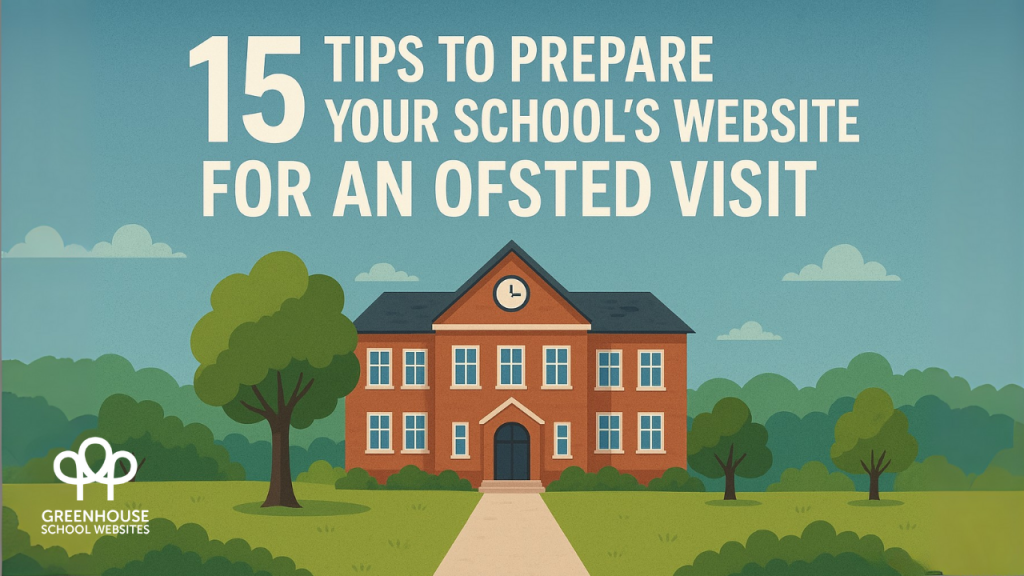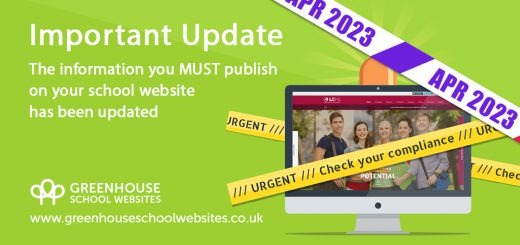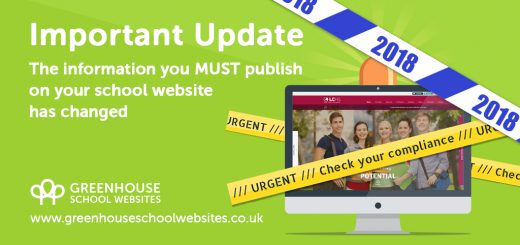15 tips to prepare your school website for an Ofsted visit

When Ofsted calls, your website is often one of the first things inspectors review before setting foot in your school (our Ofsted early warning system even tells you when they start!) A well-prepared website not only ensures you’re meeting statutory requirements, but gives inspectors (and parents) a clear, positive impression of your school’s values, ethos, and organisation.
Below are 15 top tips to get your website inspection-ready.
1. Audit your site in line with statutory requirements
As much as we love a good website design, the fact is that school websites also have certain requirements that must be covered and these have nothing to do with the specific design of your site. Every maintained school, academy, and free school must publish specific information on their website. Ofsted inspectors will be looking for these. Start by auditing your site against the latest DfE checklist. Our FREE Ofsted checklist can help you to ensure you are meeting these requirements. Download yours via this link.
2. Keep policies up-to-date
Expired or missing policies are red flags for inspectors. Double-check statutory documents like safeguarding, behaviour, complaints procedure, SEND, and equality policies. Ideally, include the review date and governor approval date. Our School Policy Compliance Manager can help you keep on top of this throughout the year by sending reminders to key staff members when policies are due, and helping you to get them refreshed at key times.
3. Safeguarding information
Your safeguarding policy should be easily accessible and updated annually. Also consider a dedicated safeguarding page with:
- Contact details for your DSL and deputies
- Links to Keeping Children Safe in Education (KCSIE)
- Clear reporting routes for concerns
4. Publish Governor & Trustee Information
Inspectors often check governance transparency. Ensure details of governors/trustees, roles, responsibilities, pecuniary interests, and attendance at meetings are clearly published. Meeting minutes should also be available and easy for parents to find too.
5. Curriculum detail
The DfE requires schools to publish curriculum information by subject and year group. Go beyond a generic overview – provide enough detail so parents and inspectors can see progression, intent, and key stages clearly. Looking for inspiration on how to make yours engaging and easy-to-read? Our portfolio of websites can give you some ideas. Search by school phase or type.
6. Pupil Premium and other ring-fenced funding
You must publish a clear statement on how your school uses Pupil Premium, Sports Premium and recovery funding, and the impact of this spending. Use simple, parent-friendly language and include measurable outcomes. You can also jazz this up a bit with a photo gallery showing children enjoying sporting activities or special days out etc as appropriate. (This should be careful, of course, not to specifically identify which children are in receipt of individual funding.)
7. Accessibility and usability
Ofsted will want to see how well you communicate with parents and the wider community. Make sure your site is:
- Mobile-friendly
- Easy to navigate
- Written in plain English (jargon-free)
- Compliant with accessibility standards (e.g. alt text for images)
(Of course your Greenhouse Schools Website will already be wonderful to look at and easy to use and navigate! But do check on the pages staff are adding regularly to ensure everything is easy to access.)
8. Easy-to-find information
Don’t make inspectors dig for information. A dedicated “Statutory Information” or “Ofsted Requirements” page is a great way to collate mandatory documents in one click. In general of course your website should be easy for parents to find information quickly too. So have a regular check by looking through your website as if you are a visitor and see how quickly you could find things.
9. Admissions information
Your admissions arrangements must be clear, up to date, and include the local authority link. Ensure application deadlines and oversubscription criteria are visible.
10. Celebrate your school ethos
Statutory content aside, your website is a showcase and a chance to tell everyone about your specialisms, facilities, alumni and current student progress. Use it to highlight your values, community links, and enrichment activities. A homepage that reflects your ethos sets the right tone before inspectors arrive.
11. Staff list and roles
It’s not a statutory requirement to list all staff, but it helps inspectors and especially parents understand the structure of your school. At minimum, make sure leadership team details are published. You do not have to publish their photos if staff would rather not, but you might want to make avatars of them so at least parents have some idea who to look for in the playground. One of the favourite versions we have seen included mini portraits of the staff drawn by the children of the school!
12. Up-to-date news and events
A school website that looks dormant can give the impression of disengagement and seem like there is a lack of communication with parents. Keep your news, newsletters, and events calendar current. Inspectors will notice whether your website feels alive and reflective of school life. Update photo galleries regularly too so that they reflect your current cohort and recent achievements. These can make great discussion points during an inspection too.
13. Financial transparency
Academies must publish executive pay (above £100k), and all schools need a link to the DfE’s financial benchmarking service. Double-check these are live and accessible.
14. Test the user journey
Pretend you’re a parent or inspector visiting your site. Can you find the safeguarding policy within two clicks? Does the curriculum page make sense without explanation? A short user test by staff or governors can highlight hidden gaps. Think of practical things too – ask the office what the majority of calls from parents are asking of them. If they have common questions asked over the phone you could add the information clearly on the website to save the staff lots of time on repeating the same thing every day.
15. Add “nice to haves”
Beyond compliance, small touches can elevate your website:
- Professional, high-quality photography showing diversity and inclusion
- Short welcome video from the headteacher
- Social media integration (such as with our Social Walls)
- Quick links to newsletters, calendar items, and term dates
- Clear contact forms and maps
These aren’t statutory, but they demonstrate pride and professionalism. Remember that a school website is for everyday school life, not just for inspections, but that following all the tips above will help you to stay on top of your statutory and general website needs at all times. Tip: Schedule a termly website audit (assign a governor or SLT member). This helps you stay inspection-ready all year round rather than scrambling when the call comes.













